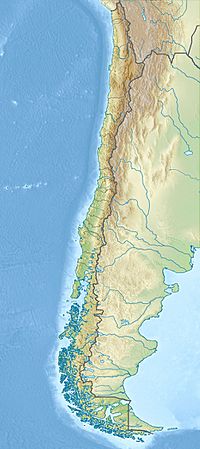Telmatobius vilamensis facts for kids
Quick facts for kids Telmatobius vilamensis |
|
|---|---|
| Conservation status | |
| Scientific classification |
The Telmatobius vilamensis is a special type of frog that belongs to the Telmatobiidae family. It is only found in northern Chile. This frog is known from just one place, the Vilama River, near San Pedro de Atacama. Its name, vilamensis, comes from this river. Scientists are not sure if this frog is still alive today. Some even think it might be the same species as another frog, Telmatobius halli.
About the Vilama Frog
When scientists first described this frog in 2003, they thought it was a new species. However, more studies have shown that it is very similar to two other frogs: Telmatobius dankoi and Telmatobius halli. This means that all three might actually be the same kind of frog. Scientists are still working to figure this out!
What Does It Look Like?
Adult male Vilama frogs are about 4.5 to 5.1 centimeters (about 1.8 to 2 inches) long. Adult females are a bit smaller, around 3.8 to 4.8 centimeters (about 1.5 to 1.9 inches) long. These frogs have a sleek, streamlined body shape. This helps them move easily in water.
Their head is big and wide, and it looks a bit flat. The front part of their face, called the snout, is pointed. They do not have an outside eardrum, called a tympanum. Their fingers have rounded tips and no webbing. But their middle fingers have small fringes on the sides. Their toes also have rounded tips and are webbed. This helps them swim.
The top of the frog's body is dark green with dark brown spots. Its belly and throat are white.
The largest tadpoles (young frogs) can grow up to 8.4 centimeters (about 3.3 inches) long. Their body alone can be up to 3.4 centimeters (about 1.3 inches) long.
Where Does It Live and Why Is It in Danger?
The Vilama frog was first found in the Vilama River. This river is in the mountains, in a dry area with very few plants. It is about 2,500 meters (about 8,200 feet) above sea level. Scientists found these frogs and their tadpoles in the water, hiding among plants along the riverbanks.
This frog lives in a very small area. Because of this, it faces many dangers. One big problem is water pollution from mining activities nearby. Also, people take water from the river for drinking and for farms. Even fun activities like recreation can harm the frogs' home.
The Vilama frog is not found in any protected areas. This means there are no special rules to keep its habitat safe. In 2016, a sudden flash flood hit the Vilama River. This flood may have destroyed the only place where these frogs were known to live. Because of this, the Vilama frog might already be extinct. However, if it turns out to be the same species as T. halli, then it might not be gone forever.



